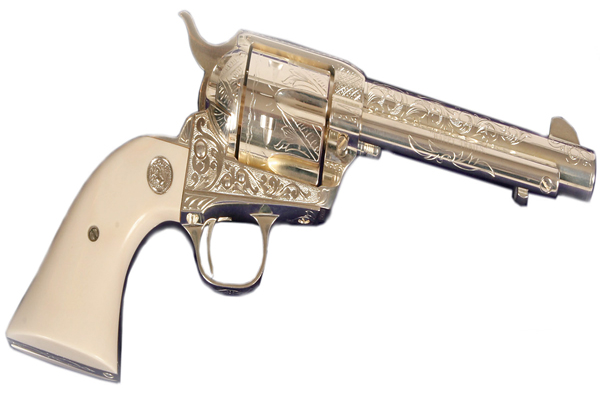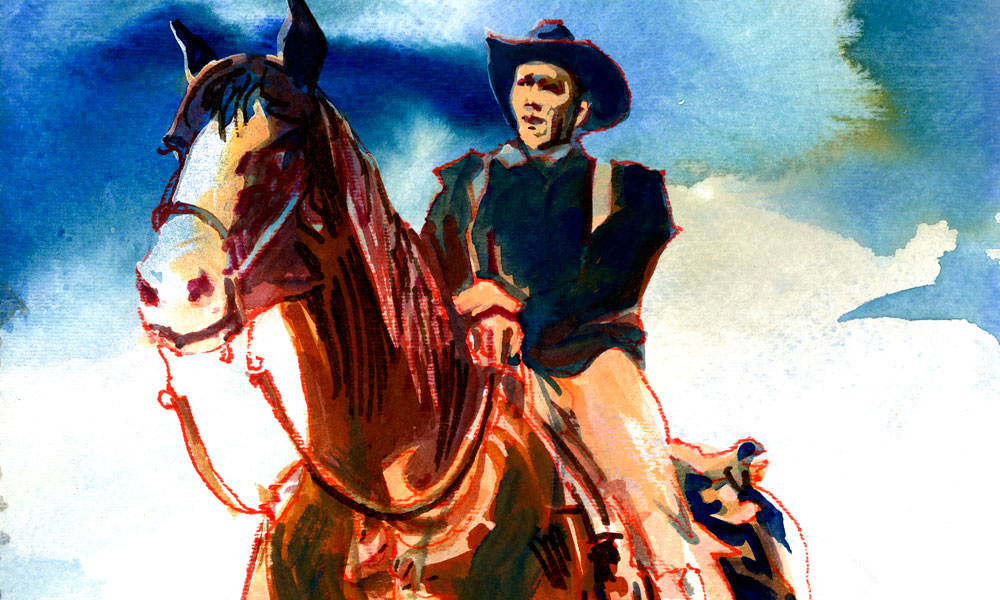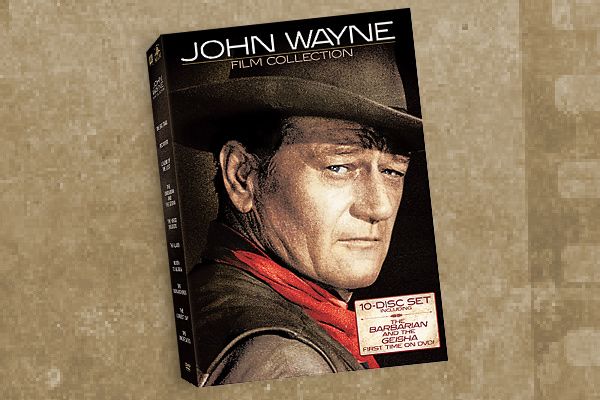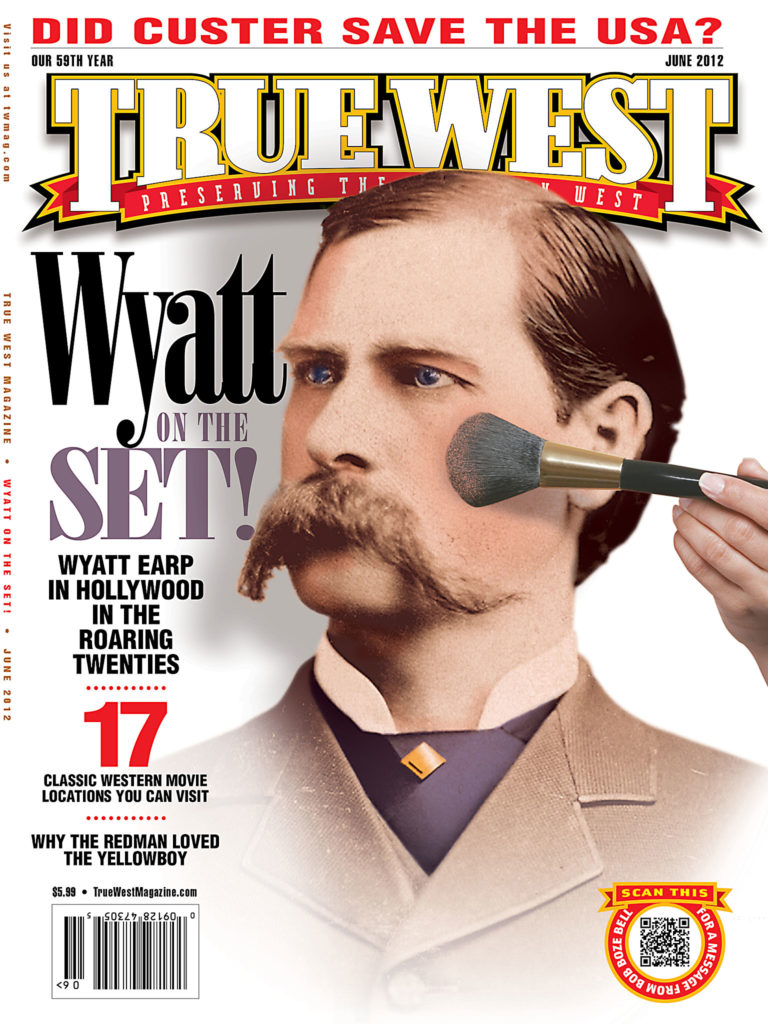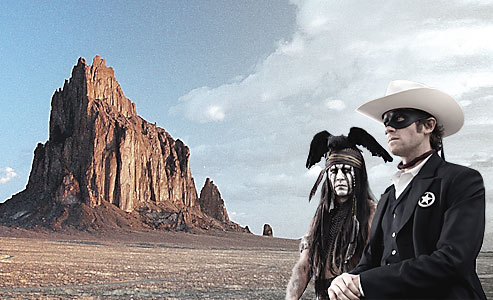 With Johnny Depp riding around New Mexico this summer for Disney’s Lone Ranger—in and around Albuquerque, Santa Fe, Shiprock and other locales—we thought it was high time for us to share some other popular locations where major Westerns have been filmed.
With Johnny Depp riding around New Mexico this summer for Disney’s Lone Ranger—in and around Albuquerque, Santa Fe, Shiprock and other locales—we thought it was high time for us to share some other popular locations where major Westerns have been filmed.
Cowboys & Aliens
Bonanza Creek Ranch, a working cattle ranch, lies southwest of Santa Fe, New Mexico. “The bones of a town were there, and we built Absolution up around them,” explained producer Roberto Orci, talking about the circa 1875 landing place for the army of hostiles invading Cowboys & Aliens.
Sheriff Taggart has been here before, when Keith Carradine, who plays him, acted with stars Kirk Douglas and Johnny Cash in the 1970 Western A Gunfight. Hollywood first showed an interest in the ranch for 1955’s The Man from Laramie, starring Jimmy Stewart. Cowboys & Aliens viewers will recognize it from the movie’s opening scenes and from the alien attack on the town.
Another ranch near Santa Fe, San Cristobal Ranch, saw key scenes being filmed, particularly when it served as the backdrop for the high-speed chase between the horseback heroes played by Daniel Craig and Harrison Ford, and the alien spaceships speeding above them.
The white sandstone cliffs and towering spires of Plaza Blanca is where Ford and Craig come across an 80-foot metal structure that temporarily houses the alien invaders. Other Westerns filmed here include The Missing, 3:10 to Yuma, City Slickers and Young Guns.
Other New Mexico backdrops for confrontations with the alien marauders included Abiquiu Lake, the circa 1550 Santa Clara Pueblo and the red sandstone cliffs along the Kitchen Mesa trail at Ghost Ranch in Abiquiu, the former home of Western artist Georgia O’Keeffe.
While in Santa Fe, be sure to visit the Tea House on Canyon Road. Olivia Wilde, who played the mysterious Ella, blogged how she visited “on days off to sample the extensive tea list, and soak up the sun in their garden.”
The actress also got her soy macchiato at Downtown Subscription, shipped home several boxes of books from Garcia Street Books and gathered for meals with the film crew at Pasqual’s.
True Grit (2010)
The Coen Brothers sure do like Texas.
They filmed Blood Simple in Austin in 1984, their debut feature that earned the brothers the Grand Jury Prize at the Sundance Film Festival. They came home with an armful of Oscars for 2007’s No Country for Old Men, also shot in Texas. And for 2010’s True Grit, they returned to Austin and also shot scenes in other Texas locales: Blanco, Bartlett, Bastrop and Granger.
Some sites you’ll recognize include: Austin’s Texas Capitol and Austin Club on 9th Street for the Memphis scenes; the 1885 courthouse in Blanco; the Steiner Ranch, outside Bastrop, where Mattie visits Cogburn’s headstone; and the 1882 town of Granger itself, which the filmmakers felt most resembled Fort Smith, Arkansas, in 1875. Walk on Granger’s red brick paved main street of Davilla, visit the Granger National Bank that housed the marshal’s office and an attorney’s office, and eat some chicken fried steak, like the famished crews did, at the Cotton Club restaurant and dance hall.
Filming also took place in New Mexico—Garson Stages in Santa Fe, Buena Vista Ranch in Mora, San Cristobal Ranch in Lamy, the Santa Clara Pueblo, the Pecos River at the Pecos Monastery and the Charles R. Ranch near Las Vegas.
Of course, in Fort Smith, Arkansas, the national historic site of Fort Smith shares documented marshals’ stories, Judge Isaac C. Parker’s courtroom and the reconstructed gallows. Another fun place to visit is Rattlesnake Cave, near Davis, Oklahoma, which inspired True Grit’s climatic scene.
Paint Your Wagon
Ben Rumson (Lee Marvin) and Pardner (Clint Eastwood) go on a gold prospecting mission in a tent city boomtown. The twist to the story is that they both have the same wife, whom they had purchased from a Mormon—Elizabeth (Jean Seberg).
Strangely, Paramount insisted on shooting this 1969 film on location near Baker City, Oregon; director Joshua Logan would have been just fine filming on the Paramount backlot.
The gold rush shantytown of No Name City was built at East Eagle Creek, within the Wallowa-Whitman National Forest. Jerry Gildemeister, the timber manager with the Forest Service, assisted Paramount in finding the location. Since scripting at the time called for flooding the town, he recommended East Eagle because the area periodically sustained heavy flood damage.
The set was torn down after filming, but the drive to the site is a beautiful one. Bask in the meadows, granite peaks and high alpine lakes of the Eagle Cap Wilderness that was once the summer home of Chief Joseph’s band of Nez Perces. Make your way down that winding dirt road to East Eagle trailhead, which will take you to the site.
Some exterior scenes were shot in California, specifically in Holcomb Valley, north of Big Bear Lake. This is located in the real gold rush country of San Bernardino National Forest; overland travelers from Salt Lake found gold here in 1849.
Stagecoach
George B. Seitz may have been the first to film in Monument Valley, for his 1925 film The Vanishing American, but John Ford was the one who reintroduced the site along the Arizona/Utah border when he directed this 1939 film.
Star John Wayne was the only principal who trekked out to this striking land of flat-topped mesas within the Navajo Tribal Park. He would return to Monument Valley to star in Ford’s 1948 film Fort Apache and 1949’s She Wore a Yellow Ribbon.
Other sites worth visiting are the salt flats at Muroc Dry Lake, near Victorville, California (the Apache raid), Kern River near Kernville (river crossing scene) and the Beale’s Cut in Newhall. This wagon cut was deepened by Gen. Edward Fitzgerald Beale in 1863 and became a popular location for silent and Golden Age Westerns. In fact, Ford had Tom Mix jump over the pass for his 1923 film Three Jumps Ahead.
Hud
A bad guy makes good when Paul Newman’s Hud Bannon descended on the sleepy Panhandle town of Claude, Texas. Walking around Claude is just like walking in the Bannon family’s hometown.
Hud premiered at Claude’s Gem Theatre, which now also houses the Armstrong County Museum. This theatre also hosted the premiere for Charles Goodnight’s silent movie, Old Texas, which he filmed on his JA Ranch southeast of Amarillo. The oldest privately owned cattle ranch in Palo Duro Canyon, JA Ranch was founded by John George Adair and Charles Goodnight, with Goodnight herding the ranch’s cattle starting in 1878.
Larry McMurtry, whose first novel, Horseman, Pass By, inspired the film, found it fitting that Hud would be filmed so close to the JA Ranch. He also recalled in his essays on Texas, In a Narrow Grave: “Most of the filming was to be done around an old, abandoned ranch house a mile or so from Claude, but the pasture scenes would be filmed near the hamlet of Goodnight, in the rugged country bordering the Palo Duro Canyon.”
The cast and crew stayed at the Ramada Inn in Amarillo. While in town, stop for a burger at Hud’s on Amarillo Boulevard. Although we must admit, it’s not exactly Walter Jetton’s BBQ, which the crew ate everyday for lunch.
The Outlaw Josey Wales
After filming The Outlaw Josey Wales, Clint Eastwood admitted shooting it was “difficult in the sense that…we had to move a lot on that one, ’cause it’s a saga—you have to feel the traveling in the land.”
The Paria Canyon set used for the 1976 movie can now be found at Frontier Movie Town in Kanab, Utah. The movie was the last to use the 1869 ghost town of Paria. Glen Canyon was also featured.
The Mescal movie set owned by Old Tucson Studios in Tucson, Arizona, is another set the crew utilized. The studio is known to offer Saturday tours when the Mescal set is not being used for a film project, so check in to see if it is open for tours. Of course, Old Tucson is fun to visit to see the studio’s classic and new period sets; 12 new sets and three new streets opened last November at the studio’s Heritage Square. The design was led by Gene Rudolf, who created sets for numerous movies, including Young Guns II.
The Alamo (1960)
The heroic saga of Texians besieged by Mexican troops in 1836 at the San Antonio mission had been a dream project for John Wayne for more than a decade. Believe it or not, the movie almost got made in Mexico, until Texans protested.
In 1959, filming finally began in Brackettville, Texas, at Happy Shahan’s ranch, near where Arrowhead and another Alamo movie, The Last Command, had been made. For this film though, a $12 million set of the Alamo compound was built. The set is still around, although it is no longer open to the public.
You can visit the real Alamo mission in San Antonio. Some things you will learn while you are here is how the mission has changed since the battle, such as the fact that the famous hump you see on the chapel today was actually built after the 1836 battle that ended the life of David Crockett and his fellow Texians.
Butch Cassidy & the Sundance Kid
While filming 1969’s Butch Cassidy and the Sundance Kid, Robert Redford admitted how happy he was to be “among my favorite scenery anywhere in the world: Silverton, Colorado, Virgin and St. George in Utah, and the Mexican desert.”
St. George and nearby Snow Canyon offered up spectacular landscapes for the film. When you step onto these sandy trails, you can just see Redford and Paul Newman being chased through the canyon, looking back and asking, “Who are those guys?”
Newman’s Butch Cassidy bicycle scene was shot at the ghost town of Grafton, just south of Zion National Park; you’ll recognize the schoolhouse, store and cabins that served as the backdrop. Newman actually performed his own stunts for that scene, except for the final backwards crash through the fence, which was reportedly performed by cinematographer Conrad Hall.
A ride on the Durango & Silverton Narrow Gauge Railroad in Durango and Silverton, Colorado, will rekindle memories of the movie’s rail robbery scenes. The canyon wall near Trimble Bridge on the Animas River is the site where Robert Redford’s Sundance Kid and Paul Newman’s Butch Cassidy took a breathtaking leap into the river (no, they didn’t actually jump into the river).
End your tour with a drink at the 1895 bar in the New Sheridan Hotel. In the movie, this is where you first meet the Sundance Kid, playing in a blackjack game during which someone is stupid enough to call him a cheater.
Wagon Master
In the winter of 1879-80, a group of Mormon pioneers left their settlement in south central Utah to make their new home in Moab. When confronted with a formidable rock barrier, they spent months blasting away at the rock until they had carved out a passageway to lower their wagons to the Colorado River.
The trail those pioneers blazed crossed Grand Staircase-Escalante, the Colorado River, Grey Mesa and up San Juan Hill to Bluff, Utah. That Hole-in-the-Rock can be seen near Cottonwood Canyon (you can access it from Escalante or via boat from Lake Powell).
This real-life adventure was fictionalized for John Ford’s Wagon Master, the first Hollywood film to be made in the Moab area. Ford shot at the ranch owned by state highway superintendent George White, whose work improving normally inaccessible roads made him a driving force in bringing movies to Moab. Ford also shot at Fisher Towers, a scenic overlook near the ranch that towered over Professor Valley and the Colorado River.
“…we are all homesick for beautiful Castle Valley,” Ford later wrote to the Moab Chamber of Commerce. “I have never known a troupe to enjoy a location so much.”
High Plains Drifter
The town of Lago was built at Mono Lake, east of Yosemite National Park, near California’s Sierra Nevada Mountains.
Clint Eastwood himself scouted out the location. In an interview with Kathie Coblentz, he said, “I discovered Mono Lake by chance, while I was out driving around, and I was immediately taken with the strangeness of the site. The saline content is so high that no vessel can risk going out on the waters of the lake. I spent two hours wandering around in the area. Not a boat, not a living soul, only the natural noises of the desert.”
Eastwood showed the place to his art director and told him, “It’s a weird place, but that’s exactly what I want this story to be.”
The barren emptiness depicted in the opening and closing scenes of the 1973 movie was visualized in the form of Winnemucca Dry Lake near Fallon, east of Carson City, Nevada.
Little Big Man
Framed by the reminiscences of a 121-year-old survivor of the Battle of Little Big Horn—Jack Crabb (Dustin Hoffman)—Arthur Penn’s tale was filmed on the actual site of that 1876 battle. When Hoffman was acting at the Little Bighorn Battlefield and Crow Agency in Montana, it was the summer of 1969; he missed Woodstock, although, at 32, he may been too old for it anyway.
Penn made a point out of shooting at numerous Montana locations; he wanted his film to represent the West as it was, not as it was imagined. Although he admitted he wasn’t aiming for historical accuracy. “You use history and social situations for insight,” he said, “and also to say, ‘This is the way I understand the background and foreground of a given situation dramatically.’”
He shot the 1970 movie in the Billings area, at Alder Gulch, the Crow Indian Reservation in Hardin and the Cheyenne Indian Reservation in Lame Deer. The period-authentic wooden buildings collected in Nevada City also served as a movie set, as it would for other Westerns such as Missouri Breaks and Return to Lonesome Dove.
Be sure to stop for a drink at the Bale of Hay Saloon in Virginia City, another well-preserved ghost town; it’s where Hoffman’s character met Wild Bill Hickok (Jeff Corey), when Crabb himself was considering becoming a gunslinger.
High Noon
If ever a song was tied so explicitly to a movie, it was “High Noon (Do Not Forsake Me)” sung by Tex Ritter during the 1952 movie’s opening credits. Not surprisingly, it earned an Oscar for “Best Original Song.” Those opening scenes were shot at the Iverson Ranch near Chatsworth, north of Los Angeles, California.
For most of the Hadleyville town shots, director Fred Zinnemann had planned to feature the Main Street of the preserved Gold Rush town at Columbia State Historic Park. But upon the crew’s arrival, the once bleak street scene was blooming with spring greenery. Yet you will recognize the white picket fence home of the cowardly Sam Fuller (Harry Morgan), the Wilson House, built in 1876-78.
A few miles southeast of Columbia is St. Joseph’s Catholic Church in Tuolumne City; this is where Marshal Will Kane (Gary Cooper) pleads for special deputies to help him face Frank Miller (Ian MacDonald).
Along the narrow gauge Sierra Railroad is Warnerville, where the movie’s railroad station was built next to the water tower.
The noon train that ex-flame Helen Ramirez (Katy Jurado) and Kane’s wife Amy (Grace Kelly) board was pulled by the Sierra No. 3, which is preserved at Railtown 1897 State Historic Park in Jamestown. This home of movie railroads put the Sierra No. 3 back in service in 2010, so you can actually take a ride on this steam locomotive.
Appaloosa
In this 2008 Western based on Robert B. Parker’s novel, lawman Virgil Cole (Ed Harris) and his deputy Everett Hitch (Viggo Mortensen) set about to protect an 1882 New Mexico town that was being terrorized by local rancher Randall Bragg (Jeremy Irons).
Harris was also the director, and he filmed the movie in and around Santa Fe, New Mexico, including the multi-hued sandstone cliffs of Abiquiu and at Bonanza Creek Ranch. Bragg’s men chased Cole and Hitch at the Rio Grande River crossing near Algodones. Fashion designer Tom Ford’s Cerro Pelon Ranch in Galisteo is where the town of Appaloosa was constructed (the ranch set had been used the year before for the 3:10 to Yuma remake).
Although most of the film was made in New Mexico, the climactic shoot-out at the fictional town of Rio Seco took place in Austin, Texas.
We’re not sure where the crew ate during filming, but we do know some Santa Fe haunts of Ford’s he may have recommended: Horseman’s Haven Cafe (for a greasy American breakfast), Jo Ann’s Ranch O Casados (for farm-grown Mexican fare) and Geronimo (a 1756 adobe house serving up the locally favored dish, grilled elk tenderloin).
How the West Was Won
This is a movie that literally went nearly a million miles. Of course, that made sense for an epic film sharing the tale of American westward expansion through one pioneer family’s history. The locations ranged from the Black Hills of South Dakota, to the Colorado Rockies, to Bent’s Fort in La Junta, Colorado, to the Rogue and McKenzie Rivers in Oregon and to Arizona/Utah’s Monument Valley.
Director Henry Hathaway helmed the largest Indian battle ever filmed at the time in the Rocky Mountains region near Montrose, Colorado. John Ford was in charge of the Civil War sequences, though, surprisingly is not the one who shot Monument Valley for the picture (Hathaway did). George Marshall directed the railroad and buffalo stampede scenes in Custer State Park near Rapid City, South Dakota.
Some of the shots filmed in California include Henry Fonda’s cabin, at the Lone Pine Campground in Lone Pine. Also near Lone Pine, the Alabama Hills rock formations set the scene for the Indian attack from which gambler Cleve Van Halen (Gregory Peck) saves saloon singer Lilith (Debbie Reynolds), resulting in the two getting married.
Westerns actor Clark Gable married his sweetheart, Carole Lombard, in Kingman, Arizona, in 1939; the two spent their wedding night at the Oatman Hotel in Oatman. Fast forward nearly 25 years, and the town was featured in this epic Western, serving as a setting for the train robbery scene near the end. Oatman still looks like a dusty Old West town today.
This larger-than-life U.S. history lesson was all the better because of its wide-ranging, and spectacularly scenic, locations
For some Western movie hotels to consider staying at, check out “Western Movie Hotels.”


